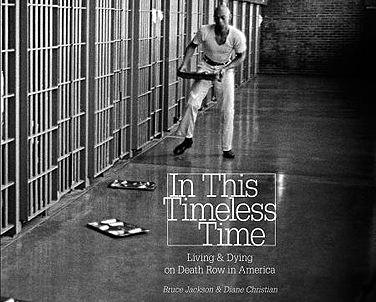News
Authors revisit world of death row

“In This Timeless Time,” the latest book by UB faculty members Bruce Jackson and Diane Christian, expands on stories in “Death Row,” a volume authored by the couple in 1979. Photo: UNIVERSITY OF NORTH CAROLINA PRESS
-
 Print
Print -
 Comments
Comments

Love of music sparks Bruce Jackson’s interest in prison culture. Read related story.
Bruce Jackson is known in some circles as the dean of prison culture. Since the early 1960s, the SUNY Distinguished Professor and James Agee Professor of American Culture in the UB Department of English has been studying the little-known lives and culture of inmates in one of America’s oldest penal institutions.
Jackson‘s work has resulted in classics of prison lore and culture, including “A Thief’s Primer” (1969), “In the Life” (1972), “Wake Up Dead Man” (1972) and in 1980, “Death Row” with his wife and collaborator Diane Christian, SUNY Distinguished Teaching Professor in the UB English department.
The couple’s latest prison book, “In This Timeless Time: Living and Dying on Death Row in America” has just been published by University of North Carolina Press in association with the Center of Documentary Studies at Duke University. It is a volume of photographs and stories illuminating the world of death row inmates in the O.B. Ellis Unit, a Texas Department of Criminal Justice prison in Walker County, Texas. It also explores what happened to those prisoners and what has happened in capital punishment practice, legislation and jurisprudence over the past four decades.
“In This Timeless Time” has been named by Publishers Weekly one of its top 10 social science recommendations in its 2012 spring books issue. The book continues and expands upon stories addressed in “Death Row” and includes a DVD of the authors’ 1979 documentary film of the same name.
Although both books feature the same subject, they take very different approaches to the story. “The first book was essentially a snapshot in time,” Jackson says. “‘In This Timeless Time’ looks back and analyzes what has happened to those inmates and to the death penalty in America since the first book was published.”
The book includes a series of 92, mostly unpublished, photographs of the Ellis unit and its prisoners taken during the authors’ fieldwork for “Death Row.” This section also offers brief notes about what happened to the photo subjects, many of whom were executed, some of whom had their sentences commuted to life, one of whom was paroled, one of whom was exonerated after 22 years on the row and one of whom is still there.
The second section explains events in the world of capital punishment over the past three decades, including changes in law and current arguments over the death penalty.
The final section discusses how the authors completed the book, and looks at the problems they encountered doing the work and their stance on ethical issues related to the death penalty and to prison reform.
“We believe that killing people in cold blood for the crime of killing people in hot or cold blood is not justified. You shouldn’t do the things you say you shouldn’t do,” says Christian, adding that in the new book she and Jackson elaborate on their points of view and consider studies on capital punishment and relevant Supreme Court decisions.
In both books, the couple describes the treatment of the prisoners as “remedial torture” and recounts the conditions the men were forced to endure, such as having the glass windows of their cells replaced with frosted glass, which not only prevented them from seeing the outside world, but caused them to develop chronic optical myopia because they could not exercise their distance vision.
The authors point out that the United States remains the only industrialized nation that still employs the death penalty. While the pace of capital sentences has slowed here, Jackson suggests it’s partly because it costs the system less to imprison a person for life than to sentence him or her to death, which involves the cost of repeated appeals and heightened security.
“In some states, legislatures have been reconsidering the death penalty, not for moral reasons, but because they’re broke,” says Jackson.
Another major change is the introduction of life without parole as a sentencing option.
“As it turns out, the main thing the juries wanted wasn’t to kill the criminals, but to get them off the street and make sure they stayed off the street,” he says.
Jackson explains that while states are becoming less likely to use capital punishment, the federal government has become more punitive and restrictive since the Oklahoma City bombing. The appeals process has become much more difficult and capital punishment is permitted for more crimes.
Prisons also have become more conservative and restrictive to outsiders wanting to come in, which would make it difficult—if not impossible—for anyone today to write a book like “Death Row” or “In This Timeless Time.” Jackson and Christian had access to the prison to photograph, film and speak to inmates three decades ago, but when they tried to go back to revisit death row for their new book, the Texas Department of Criminal Justice refused their calls and ignored their emails. Information on the inmates they interviewed in 1979 had to be culled from the prison system’s online website.

Reader Comments